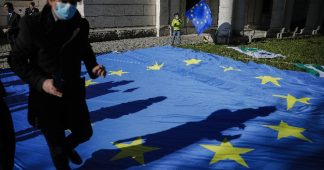Fragments of Sol Chaneles’ Lost Manuscript
If America is the world’s living myth, then the CIA is America’s myth.–Don DeLillo
One of the alternative press’s most significant scoops of the 1960s was Sol Stern’s February 1967 Ramparts magazine’s exposé revealing that the Central Intelligence Agency had long secretly funded and controlled the National Student Association (NSA). The story was significant because it revealed the NSA was a CIA front, but its greater significance came with the many derivative investigative journalistic pieces published in the months that followed. This later wave of stories used Stern’s methods of tracing CIA funding fronts to reveal a hidden world of CIA infiltrations of organizations. Once Ramparts published the names of the funding fronts the CIA had used, others followed Stern’s methods and in the months that followed, dozens of news stories revealed CIA front operations. These ranged from the funding of labor unions, judicial organizations, professional associations, to publishers and organizations like the International Conference of the Boy Scouts Movement.
The basic building blocks of Stern’s methods for tracing CIA fronts had been available to the public for three years, following revelations in 1964 when some of these CIA fronts were first accidentally exposed by Congressman Wright Patman during congressional hearings searching for communist infiltrations of American foundations. In these hearings Patman questioned an IRS employee about irregularities in several foundations, and his sworn public testimony was that the Kaplan Fund was being used by the CIA to fund projects and individuals of interest to the Agency. Patman learned from the CIA the names of eight nonprofits that funded the Kaplan Fund: The Gotham Foundation, Michigan Fund, Andrew Hamilton Fund, Borden Trust, The Price Fund, The Edsel Fund, The Beacon Fund, The Kentfield Fund. Though there was some brief news coverage of these disclosures, there was no real effort to trace what happened to the CIA funds passing through these CIA fronts and pass-throughs until Stern’s Ramparts exposé.
It was during Ramparts 1967 revelatory aftermath that the world first learned that the CIA covertly funded the publication of books, when a February 1967 New York Times story revealed that Praeger Press had published an unidentified number of books “at the CIA’s suggestion.” News reports soon revealed the CIA had secretly published other books with other presses.
As some of the titles of Praeger books published became known, clear patterns of anti-communist works emerged, and publisher Frederick Praeger lied in his public statements concerning the extent of his press’ work with the CIA, claiming to have only published 15 or 16 books dealing “fundamentally with facts, history and analysis of events of Communist-bloc countries or of nations susceptible of a fall to Communism.” Praeger defended these books as having been vetted by academic experts before publication.
Years later, when testifying before Senate hearings investigating Watergate coverups, former CIA officer E. Howard Hunt, Jr., dismissed Frederick Praeger’s claims that his press only had limited involvement with the CIA. During his years at the CIA’s Domestic Operations Division, Hunt’s base of operations was the National Press Building, using as cover credentials issued form a CIA front known as “Continental Press.” In 1974, Hunt admitted to Seymour Hersh that the CIA “funded much of the activities of the Frederick D. Praeger Publishing Corporation in New York City. We Funded, to a large extent, the activities of Fodor’s Travel Guide, distributed by the David McKay Corporation.” Instead of the handful of books Fred Praeger initially claimed the CIA had published, over a thousand books were published under these programs during the 1950s and 60s.
But Praeger was not alone. Many other presses published books either subsidized or fully funded by the CIA, intended for both academic and popular audiences. Many of these CIA publishing operations targeted a liberal intellectual audience, funding literary writers at the Paris Review the CIA’s Congress for Cultural Freedom’s Encounter, or in Africa with Transition Magazine and in Latin America Combate, Mundo Nuevo, and Cuadernos. The CIA commissioned the John Wiley Publishing Company to publish Robert Moss’ book, Chile’s Marxist Experiment, which had originally been published by “a CIA publishing subsidiary,” Forum World Features. There were also hundreds of classic western works of fiction and nonfiction translated into foreign languages and cheaply printed and distributed throughout the underdeveloped world using publishers like Franklin Book Program. This was a key part of the CIA’s soft power myth-making campaign hoping to win the hearts and minds of those undecided about the merits of communism or capitalism.
Among the known presses that published CIA subsidized books were Scribner’s Sons, Ballantine Books, and G.P. Putnam’s Sons. The CIA was not the only US agency negotiating such propagandistic publishing agreements. Fitzhugh Green discovered that United States Information Agency (USIA) staff members, Louis Fanget, Donald McNeill and William W. Warner “would think of a book that could explain what the Soviets had done to hurt the freedom of its people; then they would offer Frederick Praeger or other publishers an advance to commission an author and publish his work for foreign markers, even if the topic would not normally sell abroad.” Through these and other maneuvers the US government secretly corrupted scholarship and warped academic freedom in ways that left the American public uninformed.
These CIA operations were run by liberal anti-communists who were distrusted by conservative anti-communists like Joseph McCarthy; one reason these were covert operations was to avoid the scrutiny of congressional conservatives who would not have funded these programs. With most of these publications the CIA sought to strengthen the moderate left, bolstering liberal ideology as a way of keeping thinking people from pursuing socialism or communism. Often, the CIA’s covertly subsidized titles were works that would not have made it into print without these secret patrons. There is rich irony that the secret police of American capitalism had to covertly prop-up works that could not survive the free market that the Agency was fighting to protect.
Because some of these CIA publications have been well documented in academic and popular works (e.g. that Encounter or Paris Review ran on CIA money, the CIA printed and circulated a bootleg version of Doctor Zhivago in the USSR, etc.) it might seem surprising that significant elements of this history remain undocumented. Ultimately, much of this history is intentionally unknown; certainly, the CIA knows this classified history, but no leadership in the executive, judicial or congressional branches has pursued releasing the full details of these operations. Even the groundbreaking Church and Pike congressional investigations of the mid-1970s intentionally withheld significant information they collected identifying the names of journalists and other writers they discovered had been working with the CIA.
Enter Sol Chaneles
I’ve written about these CIA book publishing programs in the past, and with all the fine books (like: Joel Whitney’s Finks, Francis Saunders’ Cultural Cold War, Hugh Wilford’s Mighty Wurlitzer) detailing CIA efforts to manipulate arts and letters during the 1950s and 60s, I figured I understood most of the terrain covered by these programs. At least this is what I thought until five years ago, when I came across portions of an intriguing manuscript at the National Security Archives.
Rutgers University criminology professor Sol Chaneles spent years during the 1980s researching and writing a book manuscript on the CIA’s covert book publishing programs of the 1950s, 60s and 70s. Chaneles’ book was never published, but portions of his manuscript, working titled, CIA and the Books, survive in George Washington University’s National Security Archive. Although the fragmentary state of this manuscript leaves sizable holes in the story Chaneles pieced together, what remains shows his lost manuscript explored new ground and was a significant works on this topic.
It appears that Chaneles completed his CIA and the Books manuscript, but the only known copy of the surviving document is incomplete, containing portions of the first chapters, then skipping from pages 256 to 294, with over 50 pages of detailed endnotes—indicating he completed a draft of the manuscript. After reading this partial manuscript in 2016 I contacted members of his department at Rutgers, and spent a significant effort locating surviving family members to try and locate a complete copy of the manuscript, but I failed to find the complete manuscript. It remains possible that the missing pieces of this manuscript may be located, but I’ve given up looking, and instead offer this exercise in fragmentology (the study of surviving fragments of manuscripts), as an effort to salvage shards of Chaneles’ analysis of the CIA’s publishing operations.
One of the strengths of Chaneles’ analysis is how he connects the CIA’s covert publishing operations of the 1950s and 60s with US book publishers’ domestic propaganda programs during the Second World War run by the Office of War Information (OWI) and other wartime intelligence agencies. During the war, the OWI secretly underwrote the publication of various books to boost American support for the war. These included works such as A War Atlas for Americans, published by Simon and Schuster with secret government subsidies. Using wartime agencies like the Council on Books in Wartime, the US government assisted with the publication of over 1,000 books, including both works of fiction and nonfiction, as well as books characterizing the enemy in ways designed to assist the American war effort. While most wartime subsidy operations ceased at the war’s end, Chaneles demonstrates that most of the early cold war’s covert CIA publication operations were essentially revitalizing elements of these wartime programs; and he shows how individuals like Harper and Row’s Cass Canfield’s wartime intelligence work was a model for the CIA’s cold war covert publishing operations.
He traced Cass Canfield leaving Harper Brothers in 1942 (later to become Harper & Row) to contribute his book publishing skills to the US government, for the duration of the war; first at the Bureau of Economic warfare, then for the Office of War Information in France and North Africa working on psychological Warfare Campaigns. Canfield’s wartime intelligence work made him a natural contact with the CIA during the Cold War. As the CIA became interested in developing secret operations underwriting the production of books supporting CIA objectives, both domestically and internationally, Canfield became a sort of Third Man of CIA publishing operations. He served on boards of several exposed CIA fronts (such as CIA operative Lloyd Milligan’s Indonesian bookstore front, Pacific Books and Supplies), even playing an ambiguous role in the CIA’s efforts to quash publication of Alfred McCoy’s classic book The Politics of Heroin.
Chaneles traced how the Department of State’s Committee on Books Abroad drew on the talents of New York’s established publishers (Harper & Row’s Canfield, Thomas Crowell’s Robert Crowell and Macmillen’s George Brett), to oversee these covert publication efforts. He documented how Marshall W. Fishwick, Wemyss Foundation Director helped channel CIA funds for publications, and he identified patterns of revolving doors between State, CIA, and the publishing industry, such as tracing Dan Lacy’s 1954 moved from coordinating the CIA and State Department’s cover book subsidy operation to organizing the National Book Committee. He tracked some of the Asia Foundation’s publishing operations; and while the surviving coverage of these Asian operations are sparce, Chaneles established that the CIA was involved in significant covert publishing operations in the United States and abroad.
Two sections of the manuscript focus on a 1974 federal lawsuit, United States of America, Plaintiffs v Addison-Wesley Publishing Company (along with another twenty other named publishing companies). In this suit, the Justice Department charged “21 major American publishing houses with conspiring to illegally divide world markets among themselves for the sale of books.” As part of this conspiracy, the US government alleged that since 1947 these publishing houses had established an agreement to “allocate exclusive marketing territories throughout the world” and that these presses monitored and suppressed breaches of these agreements. This suit was filed during a period of aggressive anti-trust lawsuits launched by the Justice Department, coming the same month that the Department of Justice launched its anti-trust suit against AT&T. After two years of legal wrangling, all 21 publishers settled the antitrust lawsuit under a consent decree stipulating, without admitting guilt, that they would end their anticompetitive practices of underwriting agreements secretly allocating territories and markets for book sales.
Chaneles argued that the legal facts at the heart of this 1974 antitrust suit should also be applied to the non-competitive behaviors the US government undertook throughout the years of the CIA’s covert book publishing operations. He reasoned that the settlement of the USA v Addison-Wesley suit provided the basis for legal action against the US Department of State and the CIA, which, he argued, were illegal non-competitive cartels. Chaneles argued that, “it is paradoxical that the conspiracy that was shaped by the State Department, aided and abetted by the National Security Council-CIA machinery and championed by major business corporations should be terminated by a branch of the US government without any mention of the simple fact that a prime mover in the conspiracy was the government itself. The conspiracies in violation of the Sherman Act were part and parcel of the conspiracies arising from NSC covert book publishing authorizations and the plethora of laws and appropriations facilitating the continuation of the joint conspiracies. The methods of the operation among commercial publishers—all of those cited in the lawsuit were commercial publishers—were myriad.”
Chaneles used the example of Random House’s 1951 publication of Reader’s Digest author, Leland Stowe’s book, The Story of Satellite Europe: Conquest by Terror to show how the CIA bypassed the usual market forces governing books publications to guarantee sales and distribution of a book that likely would not have found a market to support its survival. He argued that “many thousands of copies of the book were purchased by CIA coordinated agencies for low cost and free distribution in the US and in those areas of the English-speaking world subject to the conspiracies in violation of the Sherman Act.”
Chaneles rejected views of the CIA as a rogue agency. He demonstrated how these covert operations were run with the approval of the Executive Branch, through the National Security Council, and 303 Committee. These covert publishing operations were approved by presidents from Truman through Johnson,“until 1964 NSC 10/2 and NSC 10/4 and, doubtless other ‘top secret’ directives still protected by the iron gloves of national security facilitated the covert allocation of billions of dollars in subsidies to American book publishers and their overseas subsidiaries and affiliates, including publishing companies wholly owned by the US government through dummy, cloaking devices. If there were members of the government with the secret publishing operations, they maintained a policy of silence. If leaks were made to journalists, publishers refused to print the accounts.”
Chaneles traced a wild mix of early Cold War governmental and private committees converging in the early 1950s to facilitate the CIA’s publishing operations. There was the National Book Committee (NBC), established in 1954 by book publishing lobbyist Dan Lacy, whose previous work included liaison between the Department of State and the CIA’s book subsidy operations. Chaneles determined that “NBC’s first board chairman was Whitney North Seymour, a conservative politician and Wall Street lawyer. At NBC’s inception Seymour was a board member of the CIA supported Freedom House and President of the New York City Bar Association.” There were organizations like the Government Advisory Committee on International Book Progress, which worked with the US Assistant Secretary of State for Cultural Affairs, and the Department of State’s psychological warfare unit’s Committee on Books Abroad (CBA), was directed by Sigurd Larmon, Members of the CBA included Cass Canfiled (Harper & Row), Robert L. Crowell (Thomas Y. Crowell) and George Brett (Macmillen).
These were the sort of public-private organizations mixing publishing kingpins with government figures coming from State and CIA to spread specific messages, most generally messages stressing the dangers and shortcomings of communism, targeting both domestic and foreign readers.
Chaneles argued that one of Cass Canfield’s Harper & Row authors, John Gunther was “probably the most heavily endowed recipient of CIA Largesse for his participation in the agency’s dis-informational book program.” Chaneles showed how a strategic relationship between Book-of-the-Month-Club principle owner, Harry Scherman, Canfield, and Gunther “could guarantee distribution of hundreds of thousands of books” with the assistance of “long-time member of the CIA coordinated Freedom House” while “supported by covert subsides.” Chaneles traced the roots of “Canfield, Gunter, Sherman triangle” back to the Second World War, where they worked on wartime publishing operations over seen by Allen Dulles for the OSS.
Gunther’s 1941 book, Inside Latin America, was a propagandistic summary of South American political development, which included a discussion of US efforts to expose and “rid South America of Nazi influences.” Canfield and Scherman helped publish Gunther’s 1949 Book, Behind the Curtain, which described the 1948-49 Greek civil war while avoiding discussion of the US’s role supporting right wing royalists and fascists against Marxists, and ignoring the British colonialist roots of the uprising—Behind the Curtain became a Book of the Month Club selection.
Chaneles analyzed a 1952 article Gunther wrote for Look magazine as a way of “making the CIA better and more favorably understood to the American public and to introduce the PSB [Psychological Strategy Board] people as worthy of favorable opinion.” The article fawned over these propaganda programs, and Chaneles critiqued Gunther’s support for these CIA efforts designed to “allay concerns” that the CIA and Psychological Strategy Board might be “responsible for illegal ‘dirty tricks’ at home or abroad.” Gunther’s article was heavily supervised by CIA Assistant Director (and Air Force Colonel) C. B. Hanson. Hanson provided detailed notes on a provisional draft, urging Gunther to show how agencies like the PSB had roots in the American WWII war effort. Chaneles discovered that the final version of Gunther’s Look piece was subject to “extensive CIA ordered revisions,” and it fit the CIA’s narrative so closely that Chaneles argued that “it could have been a press release written by Col. Hanson.”
The CIA’s selection of Praeger Press as one of the first commercial presses to commission books to personal connections established by Frederick Praeger during his World War II services as a combat intelligence officer. Chaneles argued that the topics, titles and forms of analysis of these Praeger published CIA sponsored books “were determined by nameless bureaucrats.” The CIA first contacted Praeger around 1950 asking him to make his press available for publishing books selected by the CIA under a covert arrangement where the US government covered all costs and the CIA guaranteed it would purchase and distribute thousands of copies of books. Chaneles wrote that, “such contracts would permit the company to overprint as many copies as it wanted and to sell them as his own product. Basically, the arrangement was little more than the establishment of illegal governmental book publishing company. From 1950 to 1967 when the first public disclosure began to appear concerning secret book subsidization via the CIA Praeger had published over one thousand covertly subsidized titles through arrangement coordinated by the CIA.”
Chaneles estimated that by the mid-1950s Praeger published between 100 and 150 CIA titles a year. One of the ways that the CIA secretly channeled money to Praeger and other presses was by covertly arranging commercial bank loans to the press. The CIA arranged loans through bankers with OSS or CIA ties, or through the Schroeder Bank, which had connections to Allen Dulles and the Rockefeller Foundation predating the Second World War. Other loans were arranged by Frank Altschul, who directed Lehman banking interests and had financial ties to Allen Dulles. Some loans carried no interest, the CIA later forgave some loans, using pass-through organizations to shelter their involvement.
Chaneles found instances of the CIA identifying small struggling presses to approach with financial offers designed to save the press. One example of this was the story of The Speller Company, which for decades had published books containing samples of wood, until the 1950s when they hit financial hard times and were considering closing the press when the CIA approached them, through the Free Europe Committee, with a lucrative offer for them to publish the magazine “East Europe” and a series of run through the CIA’s covert book program.
While the CIA claimed that it terminated its covert book subsidy program for English language books in the 1970s, Chaneles points out that in 1978, the language announcing the end of this program did not terminate “contracts already in place that had to be honored,” which left open the possibility of ongoing operations, and of course did not necessarily end the production of non-English language publications.
CIA Myth Makers
Using these Cold War covert publishing operations, the CIA nurtured myths of American capitalism at home and abroad. These published works often glossed over realities of American unexceptionalism while disparaging the possibilities of other political and economic systems. These CIA backed narratives championed global democracy while ignoring American CIA interventions undermining democratically elected governments promising greater distribution of wealth, in placed like Iran and Guatemala. While in the first and final instances the Cold War’s global inequality the CIA policed was maintained by armed forces, these ideological battles were also significant. The world of CIA publishing Sol Chaneles mapped was filled with propaganda projects devoted to myth-making, not works expanding the understanding of the world.
These surviving shards of Chaneles’ work reveal him not only breaking through many of the CIA’s bureaucracies of silence, but also connecting World War Two era techniques developed to undermine fascist ideologies with the CIA’s Cold War efforts to strengthen America’s imperialist reach in the name of free-market capitalism’s global expansion. The fundamental irony he documented was how far the CIA was willing to go to undermine what might have been a free market of ideas to hard-sell propaganda claiming the necessity of free markets. But such contradictions have always been at the CIA’s existential core. Yet even though these CIA publishing operations fought on an ideological battlefield, the CIA’s Cold War was not just an ideological conflict, it was a war over relations and means of production; a global class war fought by the CIA running arms, assassinating leaders, funding insurgents and counterinsurgency operations, with these loaded books acting as one of many weapons in this global class war.
In his 1967 New York Review of Books essay on “The CIA and the Intellectuals,” Jason Epstein observed that the depth of the CIA’s intrusion into publishing went far beyond the impacts of the specific books they secretly published. In many ways it transformed the industry as this process “was not a matter of buying off and subverting individual writers and scholars, but of setting up an arbitrary and factitious system of values by which academic personnel were advanced, magazine editors appointed, and scholars subsidized and published, not necessarily on their merits, though these were sometimes considerable, but because of their allegiances. The fault of the CIA was not that it corrupted the innocent but that it tried, in collusion with a group of insiders, to corner a free market.” One of the residual conclusions that remains with me reading the shards of Chaneles’ manuscripts is that without an accounting of exactly how much of this not-so-free market was actually cornered by the CIA during this period, it is difficult to understand how far this reach extended into works whose impacts remain with us today.
In the end, this remains an incomplete story. Incomplete because the CIA has no interest in revealing what happened, incomplete because congressional investigations were satisfied with generalities where specifics were needed, and incomplete because Chaneles’ manuscript appears to be scattered to the wind. But even with this fragmentary understanding, we can discern the basic mythos the CIA secretly tried to disseminate at home and abroad; a mythos using lies and hidden cartels to spread stories supporting the merits of capitalism and liberal ideologies.
Published at https://www.counterpunch.org/2020/09/13/fragments-of-sol-chaneles-lost-manuscript-on-cia-book-publishing-operations/











